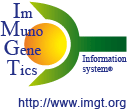HLA-G
In humans, the absence of expression of the polymorphic HLA-A and HLA-B class I molecules on trophoblast cells that are n contact with maternal tissue is compensated by the presence of HLA-C and the oligomorphic class Ib HLA-G and HLA-E.
HLA-G is expressed both as soluble and membrane-bound forms, particularly by cells of the invasing extravillous cytotrophoblast that are directly in contact with maternal decidual natural killer (NK) cells.
Three types of function have been described for HLA-G, depending on the ligand with which it interacts :
- HLA-G has the capacity to present nonamer peptides to the T cell receptor of CD8+ cytotoxic cells.
- HLA-G modulates maternal innate immunity by two distinct mechanisms. First, it interacts with some KIR and ILT expressed on decidual NK cells and macrophages. Second, the leader peptide from HLA-G binds to HLA-E with high affinity and thereby allows expression of the latter at the cell surface, where it can subsequently interact with CD94/NKG2 heterodimers expressed by NK cells and subsets of T cells.
- Finally, soluble HLA-G can induce apoptosis of activated CD8+ cells by interacting with CD8 ligand [1].
[1] Solier, C. et al. Immunogenetics, 53, 351-356 (2001).



